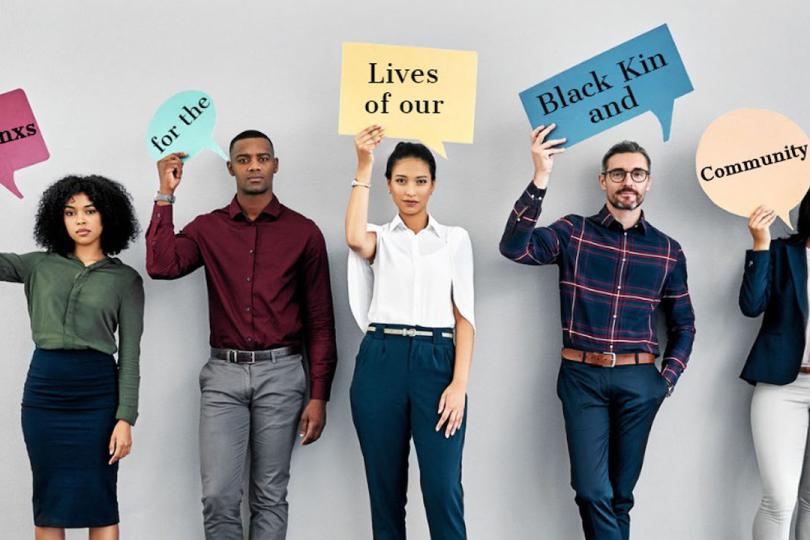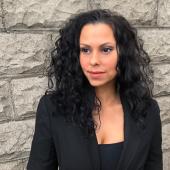Latinxs Navigating Theaters’ Reactions to BLM

I have been going back and forth about whether to write this article. Addressing what the Black Lives Matter movement means for Latinx theater artists makes me uneasy. The last thing I want to do is come across as divisive at a time when we need to be coming together to embrace our heterogeneity and uplift Black artists and stories. But conversations I am continuing to hear and read in forums for Latinx and BIPOC theater artists are already divisive; we’re having too few critical discussions. Too often we’re playing into Oppression Olympics and policing one another’s identities. I keep hearing, “Where is the outrage over Vanessa Guillen?!” and “There goes any chance for Latinxs to get cast next season.” And on the flip side, it seems Lin-Manuel Miranda is about to have his Latino card pulled for being too light-skinned.
These discussions stem from the legitimate fear about how predominantly white theater companies are responding to the BLM movement. While white employers at these theaters are genuinely trying to learn and apply anti-racist work, many are recruiting Black artists to teach them about racism and update their policies, often as their primary or sole source of education and change. There may be some good to come from this inclusive approach, but it is still an exploitative practice marketed as a “solution” in response to the BLM climate. By doing this, theater companies are reducing Black to a monolith identity. The artists they are hiring for this work are then being used to represent all people of color, even though different racialized groups are subjected to racism in different ways. In addition, these selected Black artists are not being hired in permanent leadership positions where they could enact structural change.
Instead of addressing the scarcity of BIPOC productions, many white-led theater companies’ upcoming seasons are still predominantly white, and their limited, tokenized slots are being filled with “Black productions.” This worries many Latinxs that our already limited opportunities will be even fewer (while Latinxs comprise 18% of the total U.S. population, our representation in film, theater, and other media is around 3%i). The few companies that do center Latinxs tend not to challenge stereotypes or showcase our heterogeneity, and exclusively market us as foreign instead of an intrinsic component of U.S. history and society.ii We are concerned that there will be fewer shows for us to work on and that we will continue to be misrepresented in ways that flatten or erase the complexities of our identities. However, in voicing our concerns, we need to be especially careful not to perpetuate authenticity politics, anti-Blackness, and not to accept a reductive narrative of what it means to be Latinx.
In the racial landscape of the U.S., we have been grouped together as “Hispanic,” of “Latin American” origin, and that category has erased the fact that we consist of and come from vastly different cultures and heritages. Many of us have embraced the nonbinary term, “Latinx.” While the “x” in Latinx has been criticized for not preserving Spanish-language purity, it is also in alphabetized versions of Indigenous languages that predate the Spanish colonial imposition of a foreign language on Indigenous and later African peoples.iii The X also makes me think of Malcolm X’s rejection of his inherited slave name and the acknowledgement of the African name that was stolen from him.iv That’s relevant for us too, given that many of us were brought to the Americas through the slave trade, and for many of us, our Indigenous roots have also been displaced by colonial names. Still, the origin of the word, “Latin,” only references our colonial European heritage, which is part of how we’re racialized to erase our Indigenous and African kin and community.v
Afro-Latinx stories and representation are often made invisible, even though an estimated 25% of Latinxs identify as Black, Afro-Caribbean, or Afro-Latinx. That is over 4% of the total U.S. population or 13,000,000 people.vi In the theater industry, Afro-Latinxs are often forced into roles where they are either considered solely Latinx or solely Black. Just the other day, a dark-skinned Afro-Boricua shared with me how he changed the pronunciation of his first name and dropped his Spanish surname in order to fit the dominant culture’s idea of what it means to be Black. It was his way of navigating white spaces in the hopes of people better remembering his name and to be cast more frequently. Afro-Latinxs’ multilayered identity continues to be erased as Afro-Latinxs are subjected to both anti-Latinx and anti-Black racism, including colorism--even among other Latinxs.
Mi abuela used to say to me, “tienes buen color” and call my aunt, “mi bella trigueñita.” She used to say her lineage was “by way of Spain, la Madre Patria!” While there were Afro-Boricuas in her immediate family, her words contained anti-Black sentiment. Although, she reserved her overt racism for “los Indios” and refused to acknowledge mi abuelo’s prevalent Indigenous side of the family. Mi abuela may have been carrying the racism of her generation, but I still hear echoes of that same rhetoric today, such as calling someone “negrito,” “prieta,” or “mulato.”vii We need to decolonize our mindset. We need to reject the dominant culture’s narrative of who we are and become conscious of our own anti-Black rhetoric (and Indigenous erasure, something I too need to better educate myself about), as well as how that manifests within the theater industry.
Colorism is a staple of “diversity casting” and representation that theater companies use. In order to reach their diversity quota, theater companies have a long history of casting or hiring “soft ethnics.” There’s a reason why West Side Story’s demure and innocent Maria is usually played by a thin, light-skinned Latina. There’s a reason why plays by Latinx playwrights like Lin-Manuel Miranda are more produced than others. There’s a reason why white actors with dark features continue to be cast in roles specified for Latinxs. The industry privileges what they consider to be more palatable visual representations of Latinxs. In the current BLM climate, however, many Latinxs are attempting to fight back against the imposed hierarchy of the industry, but it is too often directed at one another. Too many of us are displacing our frustrations and rehashing authenticity politics, such as the recent debate on a BIPOC forum on whether light-skinned Latinxs like Lin-Manuel Miranda are Latinx-enough.
But, mi gente, we need to remember, the ways in which Latinxs are racialized goes beyond skin color.viii Even as a light-skinned, mixed-raced Latina, I have never been referred to as white. I am still regularly mistaken as a nanny at the park, a housekeeper while staying at hotels, and a store clerk while shopping for groceries. I am still routinely asked by white artistic directors to help them “find” Latinx actors and only hired to direct “Latinx productions.” People read me as Latina primarily because of my hair type, large hips, cultural references and markers, and because of my name. Sometimes Latinxs are grouped into a racial category based on their language, or accent, even when they might otherwise appear white. Lin-Manuel Miranda, for example, is racialized by white people for his ability to speak Spanish, hand gestures and non-verbal forms of communication, and his association with Puerto Rico. While some Latinxs can visually “pass” for white, just having light-colored skin does not automatically mean a Latinx person will not be subjected to racism.
Latinxs of all colors--though surely the darker-skinned folks are disproportionately targeted--are being locked up in state and federal prisons,ix juvenile correctional facilities, local jails, and immigration detention centers. We are subjected to health disparities,x limited pathways into and through higher education,xi severe pay gaps (Latinas alone are the lowest paid demographic in the countryxii), shifting immigration policies, high rates of living in poverty,xiii and ICE raids. We are getting killed by the police at significantly higher rates than white.xiv Many of us are still literally colonial subjects. Tens of thousands of our children are still locked in cages.xv And this doesn’t even get into the countless racial microaggressions we experience every single day.
This structure of oppression manifests within the theater industry and works to keep us divided. We need to stop policing one another’s identities, as we’re just feeding into white peoples’ notions of who we are. How we’re supposed to look. How we’re supposed to talk. We’re only making it easier for the industry to produce over-simplified depictions of Latinxs. We need to work on uprooting our own anti-Blackness, such as assuming that we should be excluded from “Black productions.” We need to stop playing Oppression Olympics; we can uplift non-Latinx Black artists in the industry and still be upset that their labor is being wielded to speak to and for all peoples of color. We must rechannel our outrage and sorrow experienced within the theater industry--and the country--toward white supremacy.
Those with decision-making power are the ones establishing the terms of our inclusion in their industry. This became painfully clear to me when I was asked to assist two white artistic directors with their statements responding to the murder of George Floyd. Both statements made commitments to uphold BIPOC stories. I suggested they specifically reference Latinxs in their list of people to support. I explained that while Latinxs encompass the entire acronym, we are usually thought of as just belonging to the “POC” section. I urged them not to erase the more than 13-million Americans who are Black and Latinx. Neither took my suggestion. In those swift taps of the delete button, white theater leaders were defining what it is to be Black, and what it is to be Latinx.
Even as the largest racialized group in this country, our heterogeneity is not represented. But there is power in our numbers, if we stand together. If we link our movements, there is even greater power. We may have our own historical legacy with racism that is distinct from non-Latinx Black Americans, but we share the same overall structure of racism. Instead of saying, “Latinxs for Black Lives,” let’s shout, “Latinxs for the Lives of our Black Kin and Community!”
DEFINITIONS
Definitions written in collaboration con mi hermana, Alma Villanueva.
Authenticity Politics: When people police one another’s identities to assess the degree to which someone measures up to a particular identity. The boundaries of racial identities have been designed to be rigid and exclusive, which works to divide people and weaken a group. An identity is perceived as authentic only if it meets reductive criteria that construct a group as homogenous. The politics of authenticity denies relations and overlapping identities and erroneously asserts that one cannot have multiple identities simultaneously.
Anti-Blackness: A form of racism with its historical roots in slavery that specifically targets Black people. While racism affects different races in different ways, anti-Blackness is the specific devaluation of Black life and the oppression of people of African descent. All racialized groups need to do more work on dismantling anti-Blackness.
Anti-Latinx Racism: Racism targeting Latinx people that is steeped in histories of settler- and satellite colonialisms and imperial wars that date back to the “discovery” of Guanahani, what Columbus renamed, “San Salvador.” This colonial legacy has manifested differently in the U.S. than in other countries of the Americas. Many of us experience anti-Blackness in addition to anti-Latinx racism.
BIPOC: Stands for Black, Indigenous, and other People of Color. “BIPOC" replaces "POC" to denote all non-white peoples because often POC was used as a more palatable alternative to saying "Black people," and because Indigenous peoples were often left out entirely. All non-Black and non-Indigenous people are lumped together in the remaining three letters of the acronym, which seems to include all Mixed-Race folx too. It's important to remember that this acronym is not always appropriate to use, as it specifically includes Indigenous people; I've frequently noticed it being incorrectly used to denote non-Indigenous people of color.”
Colorism: A racist practice steeped in anti-Blackness that is ingrained in every aspect of society in which individuals with lighter skin are more valued and treated more favorably than those with darker skin.
Decolonization: The work of undoing the legacies of colonialisms that we internalize.
Erasure: To deny the complexities and heterogeneity of a group of people through simplistic depictions and narratives about that people. The perspectives, lives, and histories of non-dominant groups are often erased through misrepresentation or from a complete lack of representation.
Heterogeneity: Replaces the word “diversity” since it has been co-opted as a marketing tool to help the image of white theater companies without actually engaging in the structural changes needed for true equity. Heterogeneity acknowledges the complexities of and differences within group identities.
Latinxs: An umbrella term for the racialized group of people from the United States with African, Indigenous, and European ancestries. It is a nonbinary term that replaces “Latinos/as” and “Hispanics.” However, the word’s root, “Latin,” still privileges our European genealogy. Mi gente, we’re going to need another word that is gender-inclusive, decolonial, and that honors our Indigenous and African ancestries and identities.
Oppression Olympics: When we try to one-up one another about who’s had it the hardest.
“Passing”: A BIPOC person who is often able to navigate white spaces without being received as a racialized Other. However, the word often carries the connotation of someone using their racial privilege to the disadvantage of their community, to be a “sell out,” and sometimes to partake in the belief of their superiority because of their proximity to whiteness. While it may happen at times, such hardly encompasses the entire experiences of those who can present as white. It’s also important to note, just because a Latinx benefits from colorism does not mean they are not subjected to other forms of racialized Othering.
Racialized: The ways in which people are consolidated and homogenized of differences into a single racial category, even when they are not officially designated as a “race.” For example, American Indians, who even as diverse sovereign nations and tribes, have been condensed into the singular category, “Native Americans.” Similarly, Latinxs are considered an ethnicity by the U.S. Census, but we are treated as a monolithic group like other groups categorized as “races.”
Racial Microaggressions: Seemingly small acts of individual and interpersonal racism that add up over time. They help to uphold structures of oppression.
Soft Ethnic: A term used in casting for a BIPOC who closely approximates whiteness--such as an individual with lighter skin and without a heavy Spanish accent--yet who is still perceived as racially Other.
Structures of Oppression: A social system in which certain groups have greater access to social, economic, political, and legal resources, rights, and power. Forms of oppression include racism, heterosexism, sexism, ableism, and classism, among others. They permeate all aspects of U.S. society and are also expressed on the individual and interpersonal level in everyday acts.
White Supremacy: A social structure that values white lives more than others. The members of this structure hold the belief, either overtly or subconsciously, that white people are superior to those of all other races. For example, white theater leaders assuming their authority on what it means to be Latinx.
Works Referenced:
[i] Aldama, Frederick Luis, and Christopher González. Reel Latinxs: Representation in U.S. Film and TV. The University of Arizona Press, 2019.
[ii] Morales, Ed. Latinx: The New Force in American Politics and Culture. Verso, 2019.
[iii] Brammer, John Paul. “Digging Into the Messy History of ‘Latinx’ Helped Me Embrace My Complex Identity.” Mother Jones, May/June 2019 Issue. https://www.motherjones.com/media/2019/06/digging-into-the-messy-history-of-latinx-helped-me-embrace-my-complex-identity/. Accessed 26 July 2020.
[iv] Ortiz, Paul. An African American and Latinx History of the United States. Beacon Press, 2018.
[v] Tlapoyawa, Kurly. “What ‘Latinx’ Doesn’t Include.” yes!, 2019. https://www.yesmagazine.org/opinion/2019/11/22/latinx-indigenous-history-heritage/#:~:text=The%20%E2%80%9Cx%E2%80%9D%20in%20Latinx%20is,people%20it%20claims%20to%20represent. Accessed 26 July 2020.
[vi] López, Gustavo and Gonzalez-Barrera, Ana. “Afro-Latino: A deeply rooted identity among U.S. Hispanics.” Pew Research. 1 March 2016, https://www.pewresearch.org/fact-tank/2016/03/01/afro-latino-a-deeply-rooted-identity-among-u-s-hispanics/. Accessed 20 July 2020.
[vii] Vargas, Andrew S. “5 Steps Latinos Can Take to Combat Anti-Blackness.” Remezcla, 2016, www.remezcla.com/lists/culture/5-steps-latinos-can-take-combat-anti-blackness/. Accessed 20 July 2020.
[viii] Flores-González, Nilda. Citizens but Not Americans: Race and Belonging among Latino Millennials. New York, New York University Press, 2017.
[ix] “Criminal Justice Facts.” The Sentencing Project, 2019, www.sentencingproject.org/criminal-justice-facts/. Accessed 28 July 2020.
[x] Carratala, Sofia. “Health Disparities by Race and Ethnicity.” Center for American Progress, 7 May 2020, https://www.americanprogress.org/issues/race/reports/2020/05/07/484742/health-disparities-race-ethnicity/. Accessed 28 July 2020.
[xi] Batista, Angela E., et al. Latinx/a/os In Higher Education: Exploring Identity, Pathways, and Success. National Association of Student Personnel Administrators, 2018.
[xii] Delmore, Erin. “Equal Pay Day isn’t equal – Latinas are hit hardest with wage gap.” NBC News, 20 November 2019, www.nbcnews.com/know-your-value/feature/equal-pay-day-isn-t-equal-latinas-are-hit-hardest-ncna1086721. Accessed 28 July 2020.
[xiii] Noe-Bustamante, Luis and Antonio Flores. “Facts on Latinos in the U.S.” Pew Research Center, 16 September 2019, https://www.pewresearch.org/hispanic/fact-sheet/latinos-in-the-u-s-fact-sheet/. Accessed 1 September 2020.
[xiv] “1,001 People have been shot and killed by police the past year.” Washington Post, 2020. www.washingtonpost.com/graphics/investigations/police-shootings-database/. Accessed 27 July 2020.
[xv] Sherman, Christopher, et al. “US held record number of migrant children in custody in 2019.” AP News, 12 November 2019, https://apnews.com/015702afdb4d4fbf85cf5070cd2c6824. Accessed 3 August 2020.




